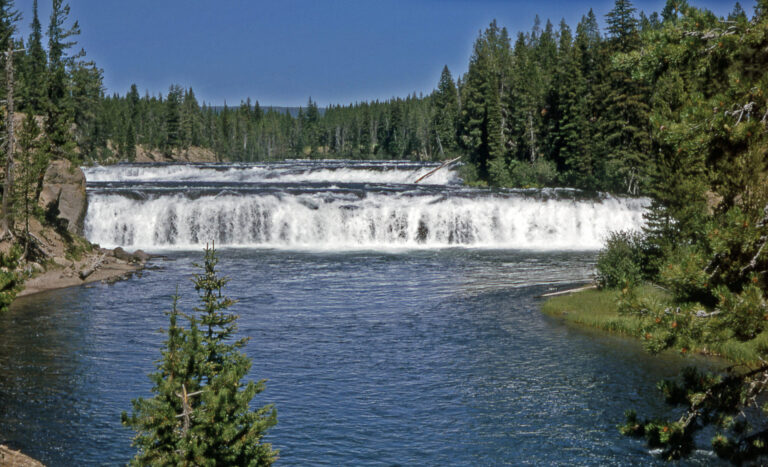It’s called the “Death Zone,” and tucked away in Idaho, it’s a 50-square-mile area of Yellowstone National Park filled with grasslands and waterfalls, home to grizzly bears but no humans.
According to a 2005 Georgetown Law Journal article, “The Perfect Crime,” it’s a place where poorly worded laws and constitutional issues collide, creating a situation where “felons can go unpunished,” Michigan State University law professor Brian C. Kalt wrote in the article.
While the whole thing sounds like a plot for an episode of the TV show “Yellowstone,” Idaho lawmakers are calling on Congress to really step in and close a questionable legal loophole.
Get morning headlines delivered to your inbox
subscribe
Rep. Collin Nash, a Boise Democrat, is introducing House Joint Memorial No. 3, which calls on Congress to close the death zone loophole.
The issue has to do with the fact that, according to the 2020 census, no one lives within Yellowstone’s 50-square-mile area in Idaho. The fact that no one lives there could be a problem if a defendant on trial for, say, a murder or kidnapping that occurred in the area were to exercise his or her Sixth Amendment right to be tried before a jury from the state and district where the crime occurred.
“So, according to legal theory, if there is no one living in that state and district in this 50-square-mile area of Yellowstone Park, then there is no constitutionally valid jury that can be selected to try that person,” Rep. Nash told members of the House Judiciary, Rules and Administration Committee on Thursday afternoon.
“What this joint memorial would do is ask Congress to fix this legal loophole that exists and place this 50-square-mile area of Yellowstone National Park in the federal judicial district of Idaho so that they can maintain jurisdiction and appoint constitutionally sound juries to try people who may have committed crimes in that part of Yellowstone Park,” Nash added.
Most of Yellowstone National Park is in Wyoming, but parts of it extend into Montana and Idaho.
 The Death Zone (highlighted in red) is defined in the southwest corner of the park, at the intersection of Yellowstone National Park (highlighted in green) and Idaho. Author unknown. Original map courtesy of the National Park Service.
The Death Zone (highlighted in red) is defined in the southwest corner of the park, at the intersection of Yellowstone National Park (highlighted in green) and Idaho. Author unknown. Original map courtesy of the National Park Service.
Responding to a question from Rep. Heather Scott, R-Blanchard, Nash said people could be tried and convicted for state crimes committed in that part of Yellowstone, but not for federal crimes.
“But to my knowledge, as far as I know, no crimes have occurred that haven’t been charged,” Nash said.
Nash, an attorney, said he first heard about the issue in law school.
Yellowstone’s “Death Zone” Issues Emerge in Gabby Pettit Case
Yellowstone’s “death zone” issue has recently gained attention in tabloid news articles and among online sleuths who were fascinated by the disappearance of Gabby Pettit in 2021. Pettit’s body was eventually discovered near Grand Teton National Park in Wyoming.
“I read about this in law school, and this story comes up from time to time,” Nash said. “I think about it whenever there’s a high-profile disappearance in the area. There were two disappearances last year, so this story came up again.”
Certainly, there were smiles and laughter to be heard at Thursday’s hearing on the death zones.
“As you’ll recall from the printed hearing, House Joint Memorial Item 3 was about death zones, which is a legal theory, not a conspiracy theory, Rep. Amador,” Nash said during the hearing, laughing with Republican Rep. Paul Amador of Coeur d’Alene.
And it’s unclear whether Congress will take the request seriously.
“I’m just curious, if we lobby the Legislature on this, do you think they’re actually going to do it?” Rep. John McCrostie, a Garden City Democrat, asked Nash.
Nash hesitated, then smiled as he told McCrostie the answer.
“We’re going to give it our all,” Nash said.
House Joint Memorial No. 3 will now be sent to the full House with the passed recommendations. The proposal, implemented as a joint memorial, will not have any binding force if adopted by the Idaho Legislature. Instead, it is intended to raise awareness of the issue and encourage Congress to act at the federal level.
Visit Yellowstone’s Death Zone for real
Unlike the main entrance to Yellowstone National Park, the southwestern part of the park in Idaho is off-limits to cars and motorized vehicles. Instead, visitors can park and stay overnight at Cave Falls Campground (first come, first served), just outside the park boundary, or park in the parking lot at Cave Falls itself. Motorized vehicles are not permitted beyond the parking lot, so visitors must walk or ride horseback to the park.
To get to Cave Falls Campground, travel east on Idaho Highway 47 through the town of Ashton, Idaho, then turn right on East 1400 North/Cave Falls Road after 5.7 miles. Follow that road for 17.6 miles until you reach the campground sign.

